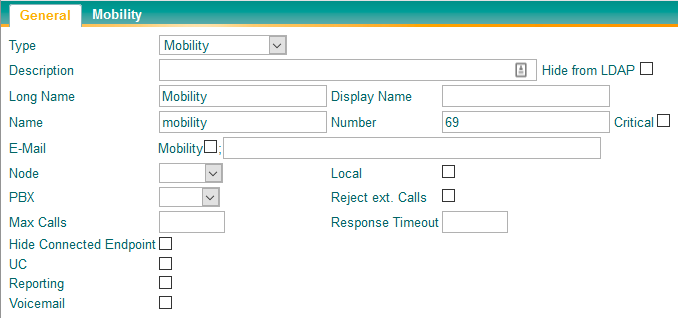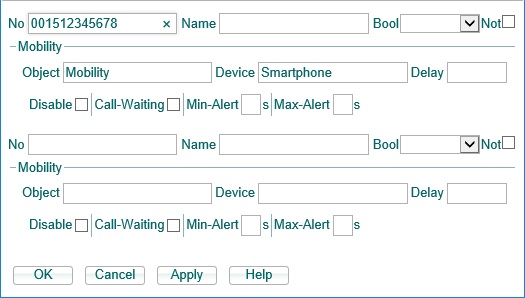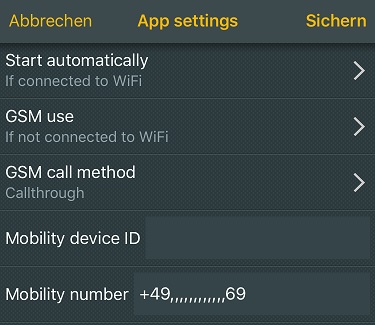Reference12r2:Concept PBX Mobility for myPBX Android/iOS
With firmware version 12r2 PBX mobility has been introduced for myPBX Android and iOS to enable call through and callback using GSM calls. This is useful if an IP connection via mobile data cannot achieve reasonable voice quality. Then it's better to delegate the calls to the GSM dialer of the smartphone or iPhone. These calls should pass through the PBX to present them to the destination with the right calling line identification and to minimize charges. For incoming calls the PBX also needs to take care to relay them to the GSM number of the user instead of placing them via IP. Active mobility calls are shown in myPBX Android/iOS.
Requirements
PBX
- Firmware version 12r2 or higher
- Mobility license matching the PBX version (enabled at the user object)
myPBX Android/iOS
- Version 12r2 or higher
The intent to make the mobility call including parameters is announced to the mobility object at the PBX via the data connection of the registration. If the registration is not up at the moment a call needs to be set up, the call through method is applied with signaling of the destination number via DTMF for both configurations, call through and callback.
Configuration
PBX
- Create a mobility object at the PBX (extension 69 in this example):
- Add the smartphone or iPhone at the user object and make sure he has a mobility license assigned. The "No Mobility" checkmark makes sure that incoming calls are placed via IP as long as the smartphone is registered and call through/callback is not active, i.e. if it is registered and call through/callback is on, this doesn't count for "No Mobility":
- Specify the mobility phone number by clicking the Fork '+' in the row of the user's PBX object:
myPBX Android/iOS
- Configure call through or callback at myPBX Android/iOS:
Start automatically
This setting controls when myPBX for Android/iOS should be active in background.
- "If connected to WiFi": The app stays active in background if connectivity is through WiFi. It quits background activity if connectivity changes to other than WiFi to make sure that it doesn't generate charges due to mobile data traffic. This is the default and it's suitable if the "GSM use" is "If not connected to WiFi".
- "If mobile data/WiFi available": It stays active in background if connectivity is through WiFi or mobile data. Note that this may generate charges due to mobile data traffic. It's suitable for all "GSM use" options.
- "Always": It always stays active in background. It's suitable for all "GSM use" options.
- "Never": It never stays active in background. If telephone functions are needed myPBX for iOS must be started manually by click on its app icon. It's suitable for all "GSM use" options.
GSM use
These are the options in which situation a call initiated in myPBX for Android/iOS is deferred to the GSM dialer. The options are
- "Never": myPBX for Android/iOS dials all calls via IP. This is the default. PBX mobility and call through/callback is not in place.
- "If registering isn't possible": Calls are deferred to GSM if the registration is not up, i.e. if no WiFi or mobile data connectivity exists. Call through/callback is not possible then. Only direct GSM calls are.
- "Always for external calls": External calls are deferred to GSM. Incoming calls are placed by the PBX via IP.
- "For all calls": All calls are deferred to the GSM dialer. PBX mobility and call through/callback is unconditionally in place.
- "If not connected to WiFi": myPBX for Android/iOS dials calls via IP only if connectivity is through WiFi. Without WiFi all calls are deferred to the GSM dialer and PBX mobility and call through/callback is in place.
The last three options are useful if the WiFi or mobile data performance is not good enough for VoIP or if there is a quota on the mobile data traffic. Then the directory and presence information is still available and the calls use the GSM network.
GSM call method
Call method for calls through GSM. The options are
- "Direct": the GSM dialer is instructed to dial the destination phone number directly. Note that the calling line identification of the smartphone/iPhone is shown at the destination.
- "Callthrough": the GSM dialer is instructed to dial the mobility phone number of the PBX. Once called, the PBX establishes the call to the destination. The calling line identification of the PBX user is shown at the destination. If the registration to the PBX is not up this method still works. The destination number is signaled via DTMF then.
- "Callback": the PBX is instructed to call back to the smartphone/iPhone. Once the incoming GSM call from the mobility object is accepted, the PBX establishes the call to the destination. The calling line identification of the PBX user is shown at the destination. Note that the registration to the PBX must be up for this to work.
Mobility device ID
Might be left blank if only one mobility device is configured at the user object. Otherwise the device name configured for this device in the mobility settings of the user object must be entered here.
Mobility number
Must be set to the full phone number of the PBX mobility object (extension 69 in this example).
Known limitations
Operations on mobility calls not available
Active mobility calls are shown in myPBX Android/iOS but operations like disconnect or call transfer are not supported.



